

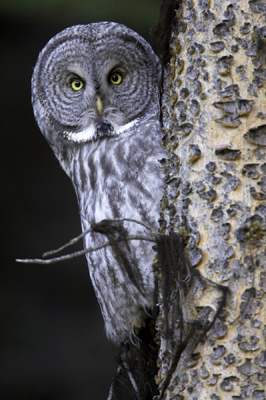
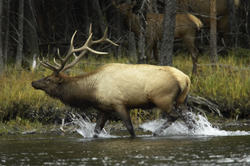
Perhaps in all of North America there is no better location to
photograph large mammals than in Yellowstone National Park. In
fall, during the annual rut of elk, moose, and pronghorn, there
is surely no better time or place to do so than in Yellowstone.
Our photo tour will do exactly that, as this tour concentrates
upon the large mammals, documenting their behavior at this most
exciting time of year. Our emphasis will be upon the elk, for
our tour should coincide with the height of that magnificent animal's
rut when bulls bugle, spar with rivals, and herd cows in their
large, much sought after harems. A common scene we've filmed depicts
a great bull bugling in a field of frost-rimmed grasses, shrouded
by brilliant early morning fog.
Of course, in the Yellowstone high country we'll also do our best to seek out other species of big game, including moose, mule deer, and pronghorn. Depending upon the physical fitness of our group, and whether big horn sheep have been spotted within a realistic hiking distance, we'll work on big horns, too, if this requires hiking. Sometimes we film big horns right from the roadside! On several trips we have had great opportunities to film GRIZZLY BEARS. On a number of days during one tour, two young adult bears, recently driven off by their mother, grazed in the high country within a few hundred yards of the road, occasionally approaching within fifty yards, and three times, actually crossing the road in front of us. Last year pine nuts failed, so as many as ten grizzlies foraged for grasses near the road. We found several. Although these opportunities may never happen again, you can be sure we'll be hoping that similar events occur again, and if they do, we'll be there ready to film.
On another tour, along with the elk and pronghorn we filmed
a huge big horn ram right from the road, and both trips had fantastic
great gray owls! You just never know what you'll find. On still
another photo tour we've had the best bull moose I've ever seen
in Yellowstone, as well as big horn sheep, another wonderful great
gray owl, mule deer, and cooperative sheep. As this paragraph
implies, each year offers its own special gems, which is why each
trip is magical and why we never get tired of going.
At this time of year the fur of Yellowstone's large mammals is
prime -- new, thick coats in preparation for winter -- and portraiture
is at its best. Filming isn't very difficult, as it can be in
winter, since deep snows will not separate you from your subject.
Finally, the huge summer tourist crowds are gone, and you'll share
the park mainly with other dedicated wildlife photographers. In
fact, autumn in Yellowstone is the annual destination of many
of North America's top wildlife photographers, and chances are
you'll meet a few while we're there!
Additionally, I feel there is another advantage in traveling with
a group. Ethical concerns regarding the harassment of animals
is a growing problem. I feel that a group has less impact on wildlife
than does an individual photographer since a group can work cooperatively
and responsibly in approaching animals, and, more important, a
group can back off as a group if an animal shows any signs of
stress. And we will do exactly that. I'm afraid that irresponsible
behavior on the part of too many may, in time, limit the freedoms
we now enjoy filming the wildlife in Yellowstone, and I for one
am going to do everything I can to keep this from happening.
Finally, if this is your first time to Yellowstone and you're
extremely interested in filming the geothermal areas and geysers,
we'd suggest that you arrive early to tour the park on your own
to do your geothermal photography. Car rentals are availalbe in
Bozeman, and you'd still be able to meet our group at the Bozeman
airport on Sunday prior to our drive to Gardiner. Some first-timers,
we fear, hope to see everything on a tour, and with the time we
devote to finding and filming wildlife, that simply won't be possible.
Usually, we do visit the scenic and geothermal areas of the park
during the mid-day hours when the light isn't especially good
for wildlife. However, we won't be spending our prime light on
geothermal activity if Yellowstone's mammals are active, for the
landscapes can be filmed before or after the rut at many different
times of the year. The rut, and the prime mammal activity, occurs
only for a limited period each fall. So, if you want old faithful
at sunrise, come early or state late and shoot that on your own.
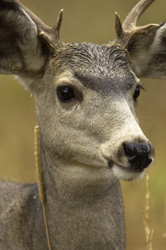 This
trip is a 'tour,' where our daylight hours will be involved in
finding, and filming, subjects. Unlike our workshops where we
conduct compositional exercises and offer review quizzes and instruction,
we'll be using our daylight hours solely for photography.
This
trip is a 'tour,' where our daylight hours will be involved in
finding, and filming, subjects. Unlike our workshops where we
conduct compositional exercises and offer review quizzes and instruction,
we'll be using our daylight hours solely for photography.
That does not imply that we're not available to help you in whatever
ways we can. Mary and I will be offering our on-the-spot suggestions
on the best way to compose the images before us, as well as suggestions
on making the correct exposures, choosing the correct lenses,
and obtaining the best perspectives. We're always there for you
-- if you have questions, if you'd like an opinion on a composition,
if you'd like to see what we're doing, whatever, WE ARE THERE
FOR YOU. On a tour, we too will be shooting but we'll be with
you, orchestrating the shoot to provide the best opportunities
for our group. We won't disappear and let you to your own luck,
although we also won't 'hang around the car' with those less motivated.
We'll be there to film, hopefully side by side with all of our
participants, and we hope that everyone will share that same enthusiasm
to photograph.
DIGITAL PHOTOGRAPHY and the workload, image management,
and editing always generates questions and opinions. On the tour
during lunches or while we're driving, or during the day if we
have the very rare day that is so miserable that we leave late
or quit early we'll have the opportunity to present our views,
and to demonstrate our workflow and editing procedures.
On one or more evenings we'll project slides or digital programs.
We'll give a short slide review of Yellowstone regarding composition
and exposure on our first evening. You are encouraged to project
40 images, too, either in the form of slides or on from your laptop
and our digital projector and one evening we'll have a chance
to enjoy, critique, and to learn from those images. This aspect
of our trips is frequently among the most popular.
Finally, we're available to answer all of your questions prior
to the trip, and we'll be anxious to assist you in your efforts
when we're afield in Yellowstone.
Yellowstone is vast, and although the average tourist thinks they can 'see' the park in a single day, our in-depth photo safari will only scratch the surface in five full days. Although the emphasis of this tour will be the large mammals, the elk, moose, and pronghorn, we'll be carefully watching for every photographic possibility. Most years the northern part of the park is best for elk and large mammals, and for that reason we'll be basing ourselves from just one motel in Gardiner. From here, adjacent the Mammoth Hot Springs, we'll work on pronghorn antelope, and hopefully moose, big horn sheep, elk, and mule deer.

We'll also head deeper into the park -- to Hayden Valley for
bison, to the Grand Canyon of the Yellowstone for scenics and
for birds, and to the Madison River for trumpeter swans. Gardiner
and nearby Mammoth are also great for elk, and we'll be within
a 45 minute pre-dawn drive to the best spots for filming elk when
the air is cold and crisp, the grasses covered with frost, and
the light is magic.
Our daily itineraries will be flexible, reflecting what subjects
we've already filmed, what we still seek, what's suddenly available,
and what the weather provides. We do not follow a strict itinerary
-- with nature and wildlife that would be foolish and counter-productive.
We follow a schedule that will provide you with as complete a
coverage of Yellowstone as is possible, and we arrange our schedule
accordingly.
Yellowstone in autumn is a magnificent landscape, and we will
take several opportunities to photograph these landscapes. Our
shooting schedule revolves around our quest for wildlife, which
generally starts at dawn, and continues as we drive to the park's
hotspots. However, en route, we'll pass great aspen groves, meadows
of fireweed, lakes filled with reflections, and forests burned
by the famous Yellowstone fires. We will be stopping to shoot
many of these landscapes, doing so depending upon the time of
day, the beauty of a scene, or the 'free time' we have between
visiting our wildlife stops.
It is our policy to stop for photos whenever we see a great shot,
whether that's an animal or a flower, and to stop whenever anyone
in our group sees a photo -- provided they let us know! We always
stress to our groups that we'll stop when anyone sees a shot,
but that we must know that they or YOU want to stop! Our point:
we wish to stress that we'll be filming both wildlife and scenics,
and that we're counting on you to help in this endeavor! Our first
priority is wildlife, but we'll do both as time and opportunity
permits.
Your fee includes the workshop and tour, field breakfasts and
field lunches, lodging (based on double occupancy), a welcome
dinner, a final farewell dinner at the finest restaurant in Gardiner,
and ground transportation. Participants will receive a food list
where we ask you to list the items you do not like; and Mary will
shop based upon these lists. Our field meals are served picnic
style, and they are very complete and nutritious. You won't be
hungry, we can assure you! Dinners or any meals taken in town
due to bad morning weather are not included in the price. We usually
eat at affordable, but very nice, diners or restaurants for our
evening meal. Prices range from $6 to $20 for most meals, and
western food is filling! On Sunday and Friday evening our participants
are treated to a Welcoming and Farewell dinners, respectively.
Transportation in the park is included in the tour price. We'll
be using two large passenger vans. Transportation includes
pickup at the Bozeman airport Sunday, around 1PM, and a return
to the Bozeman airport Saturday morning, around 11AM, and
all group transportation during our shoot in the park. Should you miss a plane or arrive late, it will
be your responsibility to meet the group at Gardiner.
You'll be required to secure your own
transportation to Bozeman if it is necessary for you to leave
the tour before Saturday morning. Mary will provide
a complete itinerary with motel phone numbers and alternative
transportation for such emergencies. We strongly advise that you
obtain trip/travel insurance if there exists the remotest possibility
that you may have to cancel at the last minute or leave the tour
before its conclusion on Saturday morning.
Lodging is included, and is based upon double occupancy. We'll
do our best to make roommate matchups, if you choose to have one.
There will be an additional charge (approx. $225) for anyone requesting
a single room. There's a space on the registration form indicating
this.
We'll be forwarding a complete list of equipment and film recommendations to our registered participants. However, this tour will require long lenses for anyone seriously hoping to shoot frame-filling portraits of elk, pronghorn, or other large mammals. I'd suggest lenses of 300mm or longer (Mary and I will be using 500mm and 600mm lenses). If you only own an 80-200mm zoom, I'd recommend either purchasing a 400mm lens or renting a telephoto, unless you will be satisfied to shoot 'mammals in the environment' type images. Sigma makes a very sharp 400mm F5.6 lens that sells for under $500, depending upon the lens mount. Too frequently people with short lenses attempt to do what people with longer lenses can do quite easily, which requires them to move in too close, either stressing the animal or putting themselves in jeopardy of being injured. Registered participants will be forwarded a complete list of suggested equipment, film choices, and recommendations.
 September's
weather can be eratic, ranging from 'typical Rocky Mountain autumns'
to nearly winter conditions. Regardless, you can expect the mornings
to be very cold, and gloves, and a wool cap, will be required.
Typically, by mid-afternoon the weather warms up, and we advise
people to wear layers that can be shed as the temperature increases.
We might have heavy snow flurries -- perhaps even a real snowfall,
freezing rain, or damp fog, too, so we advise people to pack for
cold, just in case.
September's
weather can be eratic, ranging from 'typical Rocky Mountain autumns'
to nearly winter conditions. Regardless, you can expect the mornings
to be very cold, and gloves, and a wool cap, will be required.
Typically, by mid-afternoon the weather warms up, and we advise
people to wear layers that can be shed as the temperature increases.
We might have heavy snow flurries -- perhaps even a real snowfall,
freezing rain, or damp fog, too, so we advise people to pack for
cold, just in case.
Mary will provide participants with a complete list of suggested clothing.
Please be aware, too, that your safety is our primary concern. An early fall snowfall could make driving dangerous, and portions of the park may be less accessible at these times. We will not jeopardize the safety of the group, so if the roads are bad, we'll concentrate upon the pronghorns, sheep, and elk around the Gardiner and Mammoth Hot Springs areas, where the roads are almost always passable.
 POTENTIAL SUBJECTS
POTENTIAL SUBJECTSLate September is the annual rut for the elk. We're likely
to photograph bugling, herding behavior, and perhaps males fighting.
Additionally, of course, we should be filming cows with older
calves in a variety of habitats -- along streams, near the geothermal
areas, and in meadows.
Moose bulls will be in their prime condition, and although they're
often more difficult to locate, we'll be traveling through the
best areas for moose. I'd expect us to film at least one during
our trip, but it's nature, not a zoo, and we cannot guarantee
moose. Our success rate with moose is about 50%.
We'll make a special effort to find some big horns sheep. There
are some great locations where we usually find sheep, and some
are quite close to the road. Sometimes sheep are located on high
plateaus, and we might divide the group so that those who choose
to can attempt a go of the sheep.
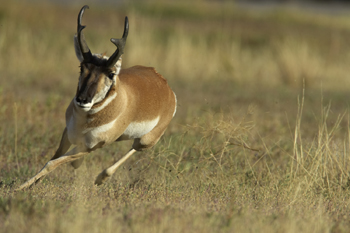 Pronghorns
will be in their best coats, and these fast-moving mammals are
fairly common and tame around Gardiner. Sometimes it takes luck
and hard work to get close to a good buck, but we're usually successful.
Pronghorns
will be in their best coats, and these fast-moving mammals are
fairly common and tame around Gardiner. Sometimes it takes luck
and hard work to get close to a good buck, but we're usually successful.
Additionally, we'll be watching for doe and buck mule deer which
are increasing since the fires of '88 and are becoming quite reliable,
coyote, and trumpeter swans. We'll have the advantage when doing
so because many animals are habituated, and very tame after dealing
with the crowds of summer, and filming some elusive subjects may
be easier, accordingly.
As I mentioned earlier, we have done unbelievably well with grizzly
bears on some of our fall shoots. Realistically, we can't expect
that to happen but you never know. It's all luck. We've often
had a mother black bear with three cubs - last year was spectacular
for bears, but each year certainly differs. Again, the bears are
there, but whether we'll be lucky or not will just depend upon
our group's luck.
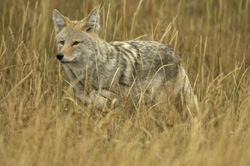 Coyotes
are usually seen in the fall, and some are quite tame. One year
we filmed a coyote that approached so close it actually sniffed
the front of one of our participant's long lens! We worked that
animal for almost an hour -- and one photographer shot 20 rolls
during that time. Gray wolves have enjoyed a tremendous comeback
since their reintroduction several years ago. Last year we missed
a kill by a day! Typically our groups see wolves, but unless a
kill or carcass is fairly close to the road photography is very
limited.
Coyotes
are usually seen in the fall, and some are quite tame. One year
we filmed a coyote that approached so close it actually sniffed
the front of one of our participant's long lens! We worked that
animal for almost an hour -- and one photographer shot 20 rolls
during that time. Gray wolves have enjoyed a tremendous comeback
since their reintroduction several years ago. Last year we missed
a kill by a day! Typically our groups see wolves, but unless a
kill or carcass is fairly close to the road photography is very
limited.
There are some other mammals too, including least chipmunks, pikas,
and red squirrels that we usually shoot, or have the opportunity
to do so. Some animals, as well as some birds like the common
raven, gray jay, and juncos, come to us while we're having our
picnic meals and, too often, they're ignored. Believe me, if it's
worth shooting I won't be ignoring a subject!
Great gray owls, North America's largest species, are uncommon
in the park, but we've had great luck over the years at frame-filling
distances with 400mm+ lenses. The owl on this brochure was shot
during last year's Yellowstone trips, but owls are tough to find
- but we've done well and we hope to again. Also, trumpeter swans
and Clark's nutcrackers are common birds we usually do quite well
in filming
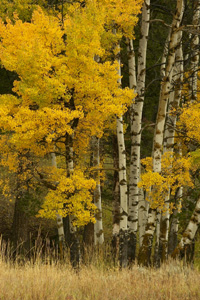
Landscapes - geysers, steam landscapes, meadows and streams, lakeshores, rivers, mountains, boulder fields, basalt columns, fireweed meadows, burned out skeletal forests, aspen groves, cottonwoods lining rivers, waterfalls -- is your appetite whetted? We'll film many of these subjects during the course of your week.
With DIGITAL PHOTOGRAPHY it is especially easy to do panorama shots where several images are shot and composited. We'll show you how to do so in the field, will show you some examples, and if time permits we will demonstrate the technique in how to put a panorama together.
Location: Based in Gardiner (Sunday night through Friday
night).
Accommodations: Lodging is included. We'll be staying at
one of the newest and nicest motels in Gardiner, the Absaroka
Lodge. Single supplement is approx.$225 extra.
Photo Tour Duration: Pickup at Bozeman airport (one time,
only) between 11AM and 2PM, on the first day of the tour. The
tour begins at 4:00PM, Sunday, on the first day of each tour.
Transportation back to Bozeman by 11AM, Saturday, on the last
day of the tour.
Transportation: Included, to/from Bozeman (one trip) and
transportation through the park. If you cannot make our pickup
on Sunday, or if you are required to leave the tour early, you
will be responsible for transport to or from Bozeman.
Costs: $1,745
including picnic breakfasts and lunches, lodging (double occupancy),
transportation from Bozeman to Yellowstone and within the park,
and all handouts. For our cancellation and payment schedule, please
see our brown sheet detailing same.
Participation: Limited to 10 participants.
Liability Release: Our release form, and perhaps one from
the national park, must be signed prior to participation.